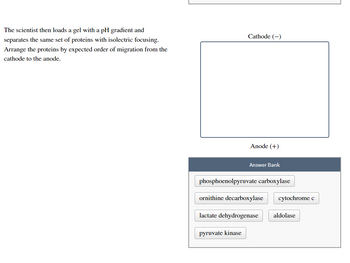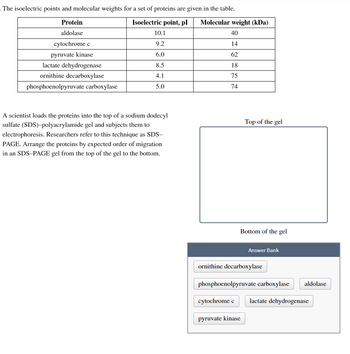
Biochemistry
9th Edition
ISBN: 9781319114671
Author: Lubert Stryer, Jeremy M. Berg, John L. Tymoczko, Gregory J. Gatto Jr.
Publisher: W. H. Freeman
expand_more
expand_more
format_list_bulleted
Question
thumb_up100%
Both pictures attached are from the same question.

Transcribed Image Text:The scientist then loads a gel with a pH gradient and
separates the same set of proteins with isolectric focusing.
Arrange the proteins by expected order of migration from the
cathode to the anode.
Cathode (-)
Anode (+)
pyruvate kinase
Answer Bank
phosphoenolpyruvate carboxylase
ornithine decarboxylase
lactate dehydrogenase
cytochrome c
aldolase

Transcribed Image Text:The isoelectric points and molecular weights for a set of proteins are given in the table.
Protein
aldolase
cytochrome c
pyruvate kinase
lactate dehydrogenase
ornithine decarboxylase
phosphoenolpyruvate carboxylase
Isoelectric point, pl Molecular weight (kDa)
40
14
62
18
75
74
10.1
9.2
6.0
8.5
4.1
5.0
A scientist loads the proteins into the top of a sodium dodecyl
sulfate (SDS)-polyacrylamide gel and subjects them to
electrophoresis. Researchers refer to this technique as SDS-
PAGE. Arrange the proteins by expected order of migration
in an SDS-PAGE gel from the top of the gel to the bottom.
Top of the gel
Bottom of the gel
Answer Bank
ornithine decarboxylase
cytochrome c
pyruvate kinase
phosphoenolpyruvate carboxylase aldolase
lactate dehydrogenase
Expert Solution
This question has been solved!
Explore an expertly crafted, step-by-step solution for a thorough understanding of key concepts.
This is a popular solution
Trending nowThis is a popular solution!
Step by stepSolved in 3 steps

Knowledge Booster
Similar questions
- Question 5 Translocation O occurs before peptide bond formation O moves the RNA four bases moves the RNA three bases. O none of the above A Moving to another question will save this response. MacBook Proarrow_forwardPlease answer subparts A B and C labor them as question 1, question 2 and question 3 because it confuses me when you all just label A, B Carrow_forwardThe following is just information that may help you answer the question. The actual question I need help with is short. It's located in the picture. Gilbert's potoroo (Potorous tridactylus, also known as the long-nosed potoroo) is a small marsupial mammal found in Australia; it is considered to be the world's most endangered marsupial. Like most animals, its genome is ~50% G-C pairs. DNA from E. coli, a species of bacteria, is also ~50% G-C. If you randomly shear E. coli DNA into 1000 bp fragments and put it through density gradient equilibrium centrifugation, you will find that all the DNA bands at the same place in the gradient, and if you graph the distribution of DNA fragments in the gradient you will get a single peak (see below). If you perform the same experiment with potoroo DNA, you will find that a small fraction of the DNA fragments band separately in the gradient (at a different density) and give rise to a small "satellite" peak on a graph of the distribution of DNA…arrow_forward
- I need help with the following question I dont understand a) and b)!!!!! Dr. Sharon Martin and her company have spent years working to identify how the gene for albinism works. The mutation in this gene causes no pigment to be produced in the hair, skin or eyes. Identifying the gene would open the door to curing the condition. Finally, her team succeeds. But, the years of research have been expensive. One way to make back the money is to patent the gene that the team members have identified. Then, anyone who wanted to develop either treatments or tests would have to pay a fee to use the gene. a) Do you think the government should allow this gene to be patented? Explain. b) If Dr. Martin’s company develops a test for this gene, should they be allowed to patent the test? Explain.arrow_forwardThis is not giving me a direct answer on what color will the eyes be off the offspring??arrow_forward
arrow_back_ios
arrow_forward_ios
Recommended textbooks for you
 BiochemistryBiochemistryISBN:9781319114671Author:Lubert Stryer, Jeremy M. Berg, John L. Tymoczko, Gregory J. Gatto Jr.Publisher:W. H. Freeman
BiochemistryBiochemistryISBN:9781319114671Author:Lubert Stryer, Jeremy M. Berg, John L. Tymoczko, Gregory J. Gatto Jr.Publisher:W. H. Freeman Lehninger Principles of BiochemistryBiochemistryISBN:9781464126116Author:David L. Nelson, Michael M. CoxPublisher:W. H. Freeman
Lehninger Principles of BiochemistryBiochemistryISBN:9781464126116Author:David L. Nelson, Michael M. CoxPublisher:W. H. Freeman Fundamentals of Biochemistry: Life at the Molecul...BiochemistryISBN:9781118918401Author:Donald Voet, Judith G. Voet, Charlotte W. PrattPublisher:WILEY
Fundamentals of Biochemistry: Life at the Molecul...BiochemistryISBN:9781118918401Author:Donald Voet, Judith G. Voet, Charlotte W. PrattPublisher:WILEY BiochemistryBiochemistryISBN:9781305961135Author:Mary K. Campbell, Shawn O. Farrell, Owen M. McDougalPublisher:Cengage Learning
BiochemistryBiochemistryISBN:9781305961135Author:Mary K. Campbell, Shawn O. Farrell, Owen M. McDougalPublisher:Cengage Learning BiochemistryBiochemistryISBN:9781305577206Author:Reginald H. Garrett, Charles M. GrishamPublisher:Cengage Learning
BiochemistryBiochemistryISBN:9781305577206Author:Reginald H. Garrett, Charles M. GrishamPublisher:Cengage Learning Fundamentals of General, Organic, and Biological ...BiochemistryISBN:9780134015187Author:John E. McMurry, David S. Ballantine, Carl A. Hoeger, Virginia E. PetersonPublisher:PEARSON
Fundamentals of General, Organic, and Biological ...BiochemistryISBN:9780134015187Author:John E. McMurry, David S. Ballantine, Carl A. Hoeger, Virginia E. PetersonPublisher:PEARSON

Biochemistry
Biochemistry
ISBN:9781319114671
Author:Lubert Stryer, Jeremy M. Berg, John L. Tymoczko, Gregory J. Gatto Jr.
Publisher:W. H. Freeman

Lehninger Principles of Biochemistry
Biochemistry
ISBN:9781464126116
Author:David L. Nelson, Michael M. Cox
Publisher:W. H. Freeman

Fundamentals of Biochemistry: Life at the Molecul...
Biochemistry
ISBN:9781118918401
Author:Donald Voet, Judith G. Voet, Charlotte W. Pratt
Publisher:WILEY

Biochemistry
Biochemistry
ISBN:9781305961135
Author:Mary K. Campbell, Shawn O. Farrell, Owen M. McDougal
Publisher:Cengage Learning

Biochemistry
Biochemistry
ISBN:9781305577206
Author:Reginald H. Garrett, Charles M. Grisham
Publisher:Cengage Learning

Fundamentals of General, Organic, and Biological ...
Biochemistry
ISBN:9780134015187
Author:John E. McMurry, David S. Ballantine, Carl A. Hoeger, Virginia E. Peterson
Publisher:PEARSON